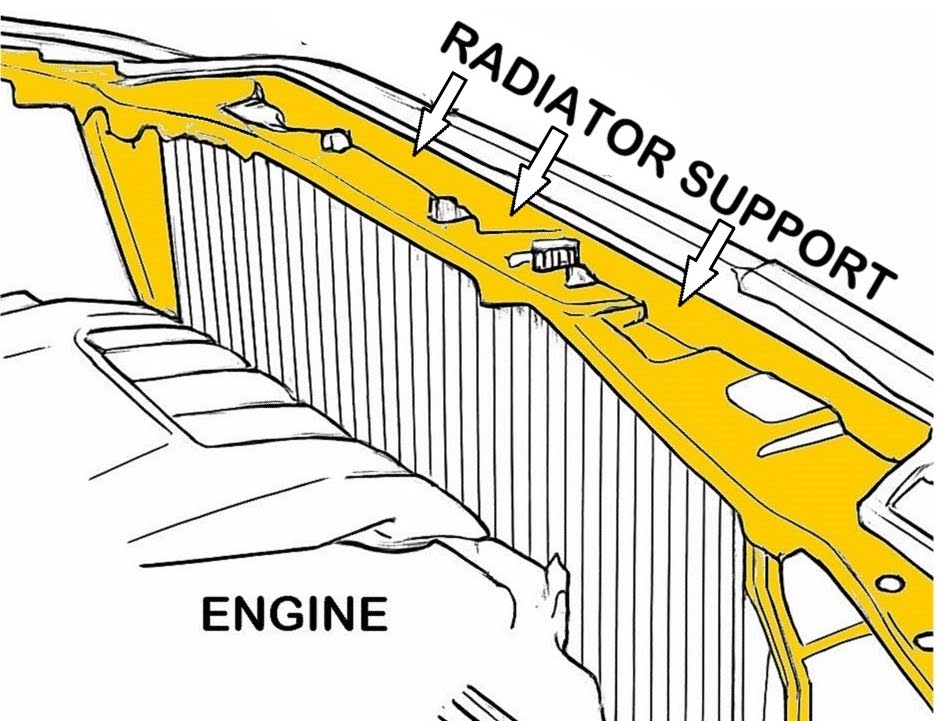When you pop your vehicle’s hood, the radiator support isn’t the first thing that grabs your attention. Still, it’s one of the most important parts holding everything together at the front of the vehicle. The radiator support is the frame that secures the radiator, but it also provides mounting points for parts like the A/C condenser, headlights, and even the hood latch. Without it, the radiator would rattle or shift out of place, and the whole cooling system could quickly fail.
Unlike small clips or brackets, the radiator support spans the entire width of the front end, adding strength and alignment. It helps keep the radiator steady while also making sure that the hood and headlights line up correctly. But over time, radiator supports can rust, bend, or crack, which not only threatens the radiator but also throws off the fit of surrounding body parts like the radiator support bracket. Knowing how this piece works and what problems to look for can save you from bigger repair headaches.

How a Radiator Support Works
Think of a radiator support as a cradle that keeps the radiator steady. It bolts or welds to the vehicle’s frame and gives the radiator a stable platform so it won’t flex or vibrate under stress. Many supports also include built-in brackets for the A/C condenser, fans, or transmission coolers, which makes them a central piece of the cooling system.
The support also keeps the front end aligned. Because it ties the hood, fenders, and headlights together, even a slight bend can throw off spacing. If the support is damaged, you might notice a hood that won’t close flush or headlights that sit unevenly.
Materials vary by vehicle. Steel supports are strong but prone to rust. Aluminum versions resist corrosion but may bend more easily under impact. Plastic supports save weight and won’t rust, but they can crack in a collision. No matter the material, the job is the same: keep the radiator and attached components stable and in the right place.
Signs of a Failing Radiator Support
Rust and corrosion
Rust is the enemy of steel supports. Once corrosion spreads, the support can weaken to the point where it no longer holds the radiator firmly.
Unusual noises
A rattling, squeaking, or clunking sound from under the hood can be a sign that the radiator support is loose or damaged. Vibrations may cause the radiator to knock against the frame.
Misaligned front end
If the hood won’t shut smoothly or your headlights don’t line up, a bent support may be the reason. Even a minor accident can throw off alignment.
Overheating
When the radiator shifts out of position, airflow can be blocked, reducing cooling efficiency. This makes overheating more likely, especially in heavy traffic.
Damage from collisions
Front-end accidents, even at low speeds, often bend or crack radiator supports. Even if the radiator itself looks fine, the support may be compromised.
Tips on How to Replace a Radiator Support
Swapping out a radiator support isn’t as quick as replacing a headlight bulb, but it’s still within reach for experienced DIYers. Here are some tips:
Check the part first
Radiator supports vary widely per vehicle. Using the wrong one can mess up alignment and cause bigger problems down the road. If you’re ordering a replacement part, check to make sure you’ve got the right one before buying it.
Expect to remove other parts
Accessing the support usually means removing the radiator, condenser, bumper, and sometimes the grille or headlights. Organize bolts and clips when you remove them to make reassembly smoother.
Work on a cool engine
Let the engine cool completely before starting, as you’ll be working near the radiator and coolant system.
Inspect nearby components
Once you’ve removed the support, check the radiator, hoses, and fans for signs of wear. Replacing them at the same time can save you further repair work later.
Know when to call for help
Some supports are bolted in, but others are welded to the frame. If welding is required, ask a professional handle to do the job.
A radiator support doesn’t draw much attention, but it’s a vital part that keeps your cooling system steady and your front end aligned. Spotting damage early can help you avoid overheating and costly repairs. And if replacement is on the horizon, knowing what to expect can make the process far less daunting.
Any information provided on this Website is for informational purposes only and is not intended to replace consultation with a professional mechanic. The accuracy and timeliness of the information may change from the time of publication.



























